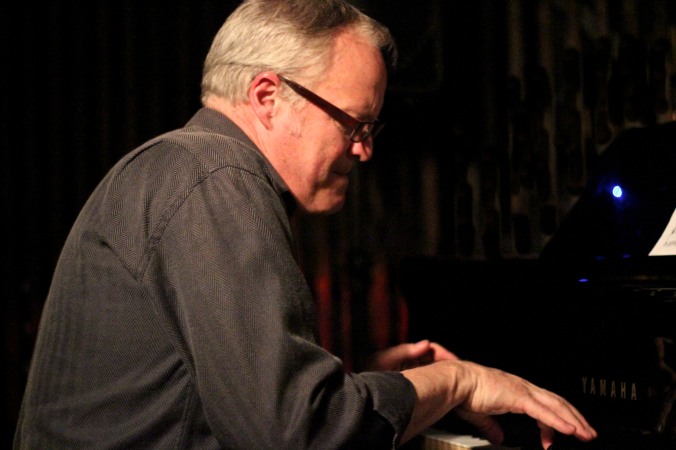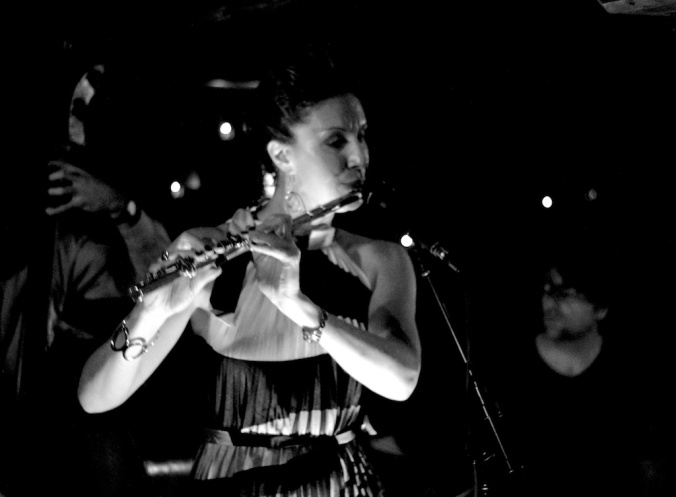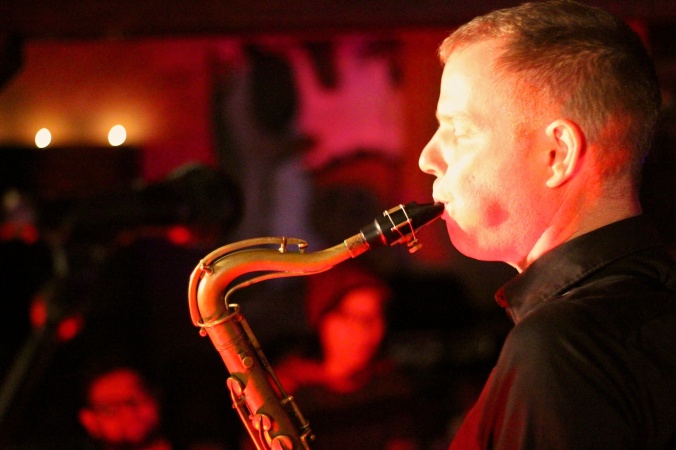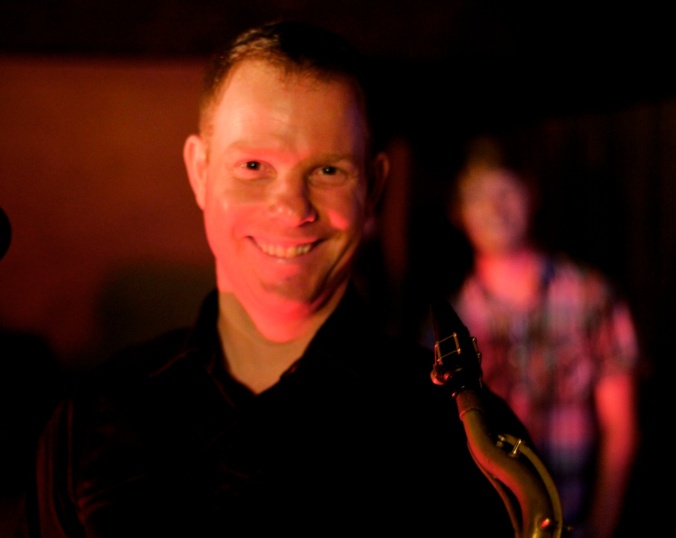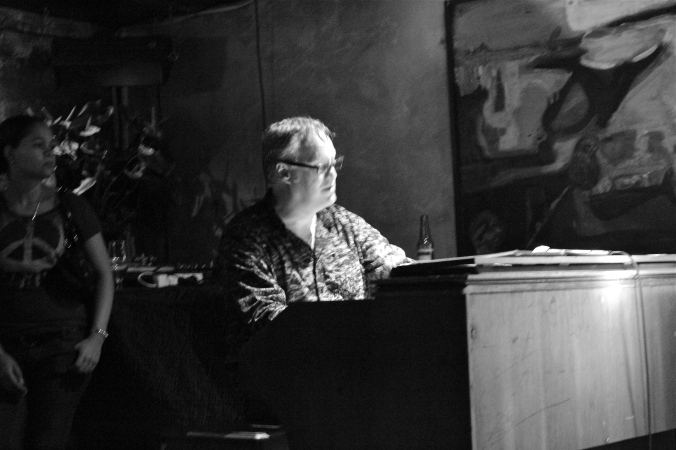The interview with Alan Brown & his band continued………

Q. Alan the world and its dog loves ‘Blue Train’. Is there any truth to the buzz about town that there will be a Blue Train reunion in 2013?
A. At least somewhat of a reunion concert is planned for the Waiheke Jazz Festival in Easter. Steve Sherriff, Jason Orme and myself recently played a lot of the Blue Train tunes at the Taste Of Auckland festival, and it all felt really good, so I thought “why not?” Once I also found out that Aaron Nevezie will be in town at the time, and was keen to do the gig, I made it happen. Aaron played guitar on the Never You Mind album back in 1998 and is a fantastic musician, and engineer/producer based in New York with his own studio, Bunker Studios. Bassist Matt Gruebner will also be visiting but won’t be here at Easter, and will only have a window of a couple of days when he and Aaron will both be here, but if I can wrangle another gig in that time frame, I will!
Q. I would love to do an updated photo essay on Blue Train. Do you have much archival material of this seminal Auckland Jazz Groove band?
A. Yes I do – I have a box of clippings, magazine articles etc, going right back to the early days when a young Matt Penman was playing with us! I also have a lot of print-outs documenting our success on the former mp3.com website back around 2000. So you’re welcome to have a sift through all that.
Q. You own the Jazz Groove space in Auckland and you are enormously well-respected about town. Do you feel a little cheated that music as well received and as popular as yours has not been picked up for wider distribution?
A. Thanks John. As Blue Train we did reasonably well and had a certain amount of recognition, but I guess it was hard for venues, labels etc to categorise us – not traditional ‘jazz’ enough for some, or too jazz for the groove crowd. Not having a singer also limited our ‘acceptance’ in the gig scene. You need to remember that NZ is still quite small, and even though there are fantastic jazz musicians and bands around, the general public don’t really get exposed to the diversity that exists. So the average New Zealanders perception of jazz is fairly limited and safe, thus it’s hard for many great artists to get a voice or get picked up. Yes it can be frustrating, but I really appreciate what people like Roger & Caroline are doing with CJC to raise the profile of what’s happening in NZ. I’ve seen many jazz bars come and go, but these guys have got it right. If anything,THEY need the wider exposure! However, I know the market is much bigger overseas, and when you check out sites like nextbop.com, you realise just how much incredible cutting-edge jazz is out there. The international market is definitely somewhere I will be focussing more on in 2013. In any case, the ability to create, produce and play ones own music is such an incredible privilege, and at the end of the day, as long as it touches or inspires even one other person, I’m happy.
Q. Tell me about a few of your favourite local musicians both in and out of your band.
A. In the band? Well, everyone! Truly, each of these players are inspiring to me, which is why I chose to work with them. Jono is an incredible drummer with an intuitive grasp of time, so with the odd-time stuff, he was the perfect choice. Plus, he shares a similar passion for Radiohead, and has a lot of good musical input, hence his assistant production role on the album. Marika has just an amazing feel and sense of groove – she knows precisely where to put the notes but also has a strong melodic sensibility. And Andy has all the rock, jazz influences but is unique. He’s a stunning guitarist and has a playfulness which works so well in this context. I have been working with David Hodkinson in bass duties of late, and he’s also a very good, keen, passionate player. He has slotted in perfectly with the band.
Outside of the band? There honestly are SO many local musicians that have inspired, or continue to inspire me. Of course Matt Penman was an early inspiration, and still is. It’s been inspiring just to see his incredible growth as a musician over the years, and he’s such a nice guy. Brian Smith was also a big inspiration – we did a number of gigs together in my early jazz years, and I learned so much from just playing with him. The list goes on: Dixon Nacey, Kevin Field, Roger Manins, Nathan & Joel Haines…in fact I really draw inspiration from all of the local players! Some of the young players coming through now, like Matt Steel, just blow me away too.
Q. You have a deep interest in many of the cutting edge Israeli Jazz musicians and in Middle Eastern folk melody. You were recently doing a masters and focusing on these works. Tell us a little about Yaron Herman and others?
A. Actually I haven’t completed my Masters yet! Still a work in progress. I did my Honours study on Avishai Cohen, as I was fascinated how he managed to blend the Middle Eastern elements of rhythm & melody, with classical and jazz, and create something that was very fresh and exciting. I’ve had a long-term love of Middle eastern music, especially the rhythm, but also the structure of it in terms of the various modes or maqams; the use of quarter-tones etc. So discovering artists like Cohen, Tigran Hamasyan, Shai Maestro & Yaron Herman has been an epiphany in jazz for me! My Masters study is partly on Yaron’s music, but also on the way he was taught.
He only starting learning piano at age 16, under the tutelage of Opher Brayer, who used mathematics, philosophy & psychology! At age 18, with a scholarship, he went to Berklee music school in the US, decided he didn’t like it, returned home via Paris, and at a jam session was offered a gig then and there. How Yaron so quickly reached such an incredible level interests me, but also the use of aspects such as psychology in the process – obviously it enabled Yaron to connect on a deep level which I’m sure is part of his rapid development. Shai Maestro, who played piano with Avishai Cohen for a while, also was taught under Opher Brayer. I’m also really digging Tigran Hamasyan at the moment – he incorporates Armenian folk tunes into his tunes, but is an incredible and passionate player. Very exciting stuff.
Q. Your music is very contemporary and reflects new streams of Jazz influence. Finally tell us about your interest in and the use of material by Bjork, Radio Head, Parks etc?
A. I’ve touched on some of these artists in terms of how aspects of their styles has been a direct influence on writing for the quartet, but I guess what attracts me is their total uniqueness, and in many cases, such as Bjork, flying in the face of trends and expectations. Radiohead did the same with Kid A. Their writing also resonates with me – and aside from adapting specific aspects of that, the emotional & spiritual affinity I have with the music is what moves and inspires me. My goal is to similarly express my heart & passion in the most complete way I can – whatever musical form that takes.
Thank you for your time Alan. Best wishes for 2013.

I also asked drummer Jono Sawyer the following questions:
Q. Jono you have played with Alan Brown for a long time and certainly from the beginning of the ‘Between the Spaces’ lineup. How did you two team up?
A. Alan was actually a key part of my love of jazz as I grew up – I used to listen to the cassette of the debut ‘Blue Train’ album in the car with my Dad when I was about 6 or so! (This album also featured my great drum teacher Jason Orme). Alan and I got to play together after I approached him to see if he’d be interested in playing on my first Honours recital when I was studying at NZSM, and I think he liked the tunes I was hoping to do for the performance so he agreed. I was actually really nervous when I approached him and never thought he’d actually do it, here was a guy I listened to from when I was a boy and helped to shape my love of music, yet he was super into it! We’ve been playing together a lot ever since cause I think we both are on the same wavelength when it comes to contemporary jazz and the exciting stuff coming out of the modern scenes, particularly New York.
Q. One day I asked you about your role in playing a groove beat across differing time signatures. You told me then that it was instinctive. Are you able to articulate the process of locating those grooves?
A. Half of the grooves are actually already written in their basic form when Alan brings a new tune to the group. He’ll demo a tune up on Logic so we get a good idea of the vibe he’s going for, and then as we practice the tune the groove becomes more refined and I add my own variances and subtleties to make it into the product… Of course, what Alan, Andy and Marika were doing would shape this; I remember the groove from ‘Sustainable Resources’ being slightly less related to the bass line at first, but as we jammed it just felt right to really articulate most of the bass line between the kick and snare, which in turn helped the flow of the tune, despite it being in 15/8 – I guess that’s where the instinct part comes in!
Q. Tell me a little about who impresses you the most from among modern drummers.
A. I have a real passion for odd time playing through my love of 70s prog rock particularly, but what really impresses me from guys like Eric Harland, Ari Hoenig and this drummer called Gavin Harrison, is how they can navigate these odd times with such flow and ease. As well as this, they never let what they’re doing get in the way of the groove and the overall musicality of the tune. Ari is certainly one of my favourite players he has such control over the drum set that he can essentially play anything he wants! But also understands that sometimes, laying back on the groove, whether it be swing or more contemporary stuff, can be all that’s necessary for a tune to become perfection. All of these great players also have a wide knowledge of the greats that have come before them, and I’m finally starting to understand the importance of this too.
Q. Where to from here?
A. Hopefully another Alan Brown album! I know Alan’s really passionate about trying to get some international gigs under our belt so that will be exciting if we get some dates lined up. I’m also keeping busy with Batucada Sound Machine, and we’re looking ahead to our European summer tour… I’m also involved in a project with the APO for a concert they’re doing in May, which should be good fun! Lots of work to do for all those things though so I’d better get practicing.

Lastly I interviewed David Hodkinson about his role on bass
I thought that I would ask a few of the other band members questions as well. The newest member of the lineup is David Hodkinson who plays electric bass. The original BTS album had Marika Hodgson on it and she had quite a following as her intense goove lines were compelling. David has seemlessly stepped into the role which was big ask and so I asked him what that was like.
Q. David, I am impressed by how you handle your bass duties in this band. How are you enjoying playing with an Alan Brown band?
A. I am really loving being a part of this group, the combination of a strong groove, interesting harmony, and odd meters make it fun on many levels! Also I consider these guys a ‘dream team‘ to play with, I have a huge amount of respect for them.
Q. How did that happen. Were you recommended by a friend, apply or were you approached directly?
A. I have known Alan for some time now, through University and playing with Trudy Lile/Mojave when he had filled in. I met Andy and Jono whilst studying too, and played in Andy’s Masters Combo. I was very excited when Alan approached me to be a part of it.
Q. Tell a me a little about who impresses you most and your influences.
A. I am a big fan of Juan Nelson from Ben Harpers ‘Innocent Criminals’ band, also players like Bakithi Kumalo from the Graceland album, and Incognito. A big thing for me in regards to musicians is what kind of person they are, I would rather work with an absolute beginner with a good attitude than the opposite.
As far as influences go, I grew up playing Jamiroquai, Red Hot Chilli Peppers, Rage Against the Machine, and then it was really Paul Norman who introduced me to jazz/funk. I credit Paul as the biggest influence in my musical life. I was lucky enough to go through Avondale College and witness players like Ben Turua, and have Max Stowers as my tutor, so I was very fortunate.
Q. I watched you play those bass groove lines once when you had no drummer in the Alan Brown band. That is a lot of weight to fall on a bass players shoulders. Was that a challenge?
A. It wasn’t really a challenge, just a shift in method. I try to get the pulse in my body through movement, which can then give me the seperation mentally to process it in the same way as if there was a drummer, good fun!
Q. Where to from here?
A. Well I’ve bought some pedals so have been enjoying experimenting with different sounds. I play in the bands dDub, and Spiral as well so I am quite content at the moment. I have also been enjoying playing double bass again so I would like to do more of that in the future.
I would like to thank Alan Brown and his band for their indulgence with this. I believe it to have been an incredibly worthwhile exercise as it gives insights into an important aspect of music within the Auckland Jazz spectrum. Sadly Andy Smith was out of town but his contribution is considerable and acknowledged here.
John Fenton
Jazz Local 32.com
0.000000
0.000000

